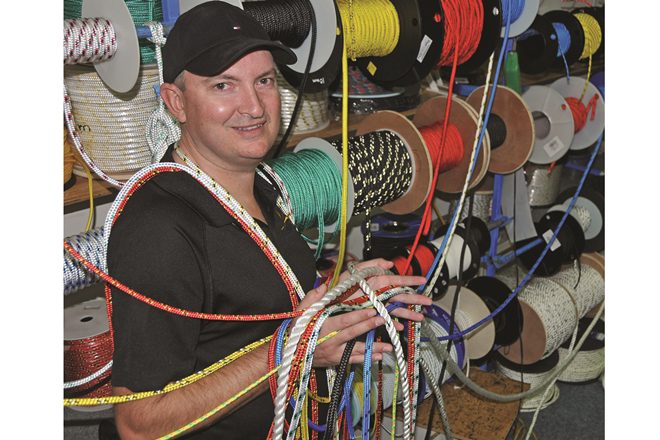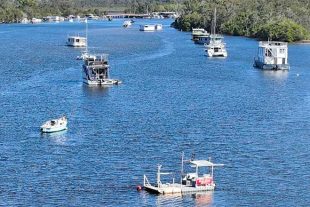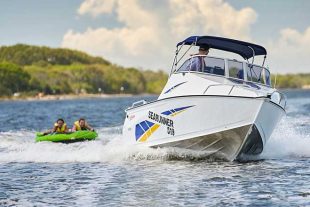WAY before Tarzan started swinging his way through the African jungle canopy on natural vines, seafarers had crafted magnificent ropes from all sorts of materials including hemp, manila and cotton, specifically for use in boats.
Coupled with a clutch of great knots like the bowline, the figure eight, the rolling hitch, the sheet bend and others, they quickly learnt some rope types were better at some tasks than others. Today there are the natural fibre ropes like sisal and manila as well as the synthetics like nylon and Kevlar – the choice and combinations are virtually limitless. But what rope types do you need on your boat?
Well that depends on what you are trying to achieve – anchoring, lashing, securing, rescuing, winching or a dozen other functions. Here’s a quick overview and some very rough price indications noting that in general terms, rope gets much cheaper the more you buy – perhaps even less than half its price per metre, if purchased in a bulk coil.
As another rule of thumb, the greater the diameter of the rope, the higher the price for that particular material. There are of course further variations according to the quality of the rope. Those variations can sometimes throw a price guide wide open and similarly, so does the overall quality and consistency of the rope over a given length.
- Nylon rope is pretty handy for anchoring small boats because it combines strength with the capacity to stretch, which makes it less likely to snap. For those same reasons, as well as the fact there normally would be a fair length of it on board if it were being used for anchoring, nylon makes a good emergency tow line if you need to assist another vessel. It doesn’t float and can be strand or braided. Cost for shorter lengths is about $2.30 a metre for 10mm diameter.
- Silver rope is made from polyethylene and is much cheaper than nylon. It is normally sold in a three-strand lay and has good abrasion resistance. That, along with being a relatively cheap rope, also makes it a good choice for anchoring. Silver rope floats and also has pretty good resistance to ultraviolet rays. The price is about $1 a metre for 10mm diameter.
- Polypropylene and polyethylene ropes are often brightly coloured with many uses. Polypropylene varies greatly from the very cheap, smaller diameter three strand often bought in hardware stores and supermarkets to be used as crab pot and camping lines, to thicker versions. Polypropylene (which is also used in car bumpers due to its capacity to spring back into shape after a low-speed nudge) has roughly twice the strength of silver rope for a given diameter. It also floats. On the downside, it has poor UV resistance. This material is very economical at around 50 cents a metre for 10mm diameter. Polyethylene eight plait is common for ski lines around 8mm diameter and selling for roughly $1.50 per metre. It is light in weight, resistant to rot, floats and is a good all-rounder.
- Ultra-high molecular weight polyethylene rope (UHMWPE) can be brightly coloured and flecked. It is an extremely tough plastic with great resistance to abrasion and friction. It doesn’t stretch much either, which, in combination with its other characteristics, makes it ideal for use on yachts (where it is called a halyard, a sheet, an outhaul, a downhaul – virtually any word other than ‘rope’). The colour and fleck options make it perfect for recognising as the rope for a particular job when there are other ropes nearby. “Grab the blue-fleck, not the red fleck” might be a captain’s call to a boating novice. UHMWPE is a quality rope and therefore is not cheap, often retailing at about $4 per metre for 6mm diameter.
- Venetian blind cord is a plaited polyester rope with myriad uses. It is particularly good for teaming with a small stainless snap hook to use as a lazy line connecting a reel to a grab rail when trolling for pelagic fish. Being stiff, the cord doesn’t flap a lot and stays out of the way when someone makes a hasty grab for the rod. Venetian cord has high strength and good UV resistance. It is also available in a variety of colours and tends to be in the smaller diameters – typically around 3mm.
- Sisal and manila ropes are twisted and give a good grip on themselves with natural fibres. That makes them handy for general uses, camping, tug-of-war games on the beach and so on. The arty-crafty types in the household might like to make them into coil mats to make a contrasting background when photographing fish – that’s a style of photo which features strongly in Ern Grant’s Guide to Fishes Both are good-looking ropes for those wanting a natural look in marine decorations. Prices vary a lot but think in terms of $1.20 per metre for 10mm diameter.
Obviously, there are many other types of rope available as well, but they are probably not quite as relevant to Bush ‘n Beach readers. For example, the double braid polyester and pre-stretched polyester ropes have high UV resistance and are a popular choice for yachting applications.
They lay well when being tidied up on a yacht and don’t stretch much which again, makes them a great choice for yachts. And there’s also the Kevlar rope, which is a very high strength braided rope that is a great choice for racing yachts where huge strain is imparted on them. No surprise that Kevlar rope is seriously expensive.
 Bush ‘n Beach Fishing Magazine Location reports & tips for fishing, boating, camping, kayaking, 4WDing in Queensland and Northern NSW
Bush ‘n Beach Fishing Magazine Location reports & tips for fishing, boating, camping, kayaking, 4WDing in Queensland and Northern NSW









